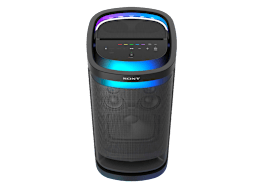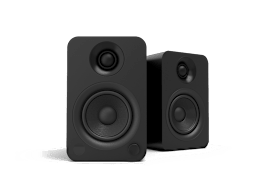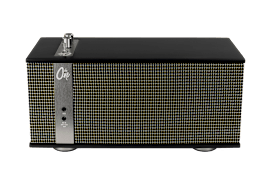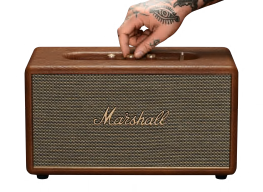Which Sonos Speaker Should You Buy?
How to make the best choice from a lineup that includes WiFi smart speakers, portables, and even models from Ikea
When you shop through retailer links on our site, we may earn affiliate commissions. 100% of the fees we collect are used to support our nonprofit mission. Learn more.

Sonos speakers are often found near the top of CR’s speaker ratings lists. And for good reason. They typically earn high marks for sound quality, ease of use, and versatility. Furthermore, they can be linked together quickly and easily using the Sonos smartphone app to form a flexible multiroom system that allows you to listen to Sarah Vaughan in the den while another family member cranks Stevie Ray Vaughan in the garage.
Sonos Five
What it is: As the company’s largest and most expensive model, the Sonos Five, which is only slightly changed from the older Play:5, is something of a classic. It achieves stereo sound from a single sizable box that can serve as the heart of a flexible multiroom system to route music throughout your home.
What’s to like: The Sonos Five simply sounds great, with solid bass and crystalline trebles that let you hear the detail of instruments ranging from the growl of a double bass to the shimmer of a ride cymbal. Our testers give the Sonos Five an Excellent rating—our rarely bestowed top grade—for sound quality when two of the speakers are paired in stereo.
What’s not to like: The Sonos Five is relatively expensive and rarely discounted. Like all the company’s speakers except for the Move and Roam, below, Sonos’ flagship is WiFi-only and needs to be plugged into an AC outlet.
Who should buy it: The Sonos Five is for the music lover who wants multiroom convenience and is willing to invest in great sound.
Sonos Move Smart Speaker
What it is: The Move represents a significant departure for Sonos, which built its reputation on home audio speakers meant to stay indoors within range of your WiFi network. The company’s first portable speaker, the Sonos Move features a rechargeable battery and Bluetooth streaming, so it can be used on the go, just like the name suggests.
What’s to like: The Sonos Move goes where you go. It’s also modestly weatherproof, although you’d best keep it under a roof or an awning rather than out in the elements. It can add Bluetooth capability to a Sonos system that would otherwise lack that functionality, adding useful flexibility when you just want to stream something from your phone. And like Sonos’ other smart speakers, the Sonos Move works with both Amazon’s Alexa and Google Assistant.
What’s not to like: The high price, which is usually around $400. Our testers found the Sonos Move’s sound quality to be quite close to that of the Sonos One SL, below, which sells for about half as much, although the Move does provide better bass. And despite its name, the Sonos Move is quite large for a portable speaker, making it more useful on a porch than in a picnic basket.
Who should buy it: A music lover looking to expand an existing Sonos system to a porch or patio.
Sonos One Smart Speaker
What it is: The Sonos One is the company’s entry-level home smart speaker. The second-generation model features an improved processor, but our testers find essentially no change in performance over the earlier model. A detailed evaluation of the Sonos One can be found here.
What’s to like: This is one of the few smart speakers that offers multiple options when it comes to digital assistants. It’s compatible with Amazon’s Alexa and Google Assistant, as well as Apple’s AirPlay. Sonically, our testers find the Sonos One’s sound to be clear and detailed, and the bass to be tight and impactful, if not super-deep. The Sonos One is a monophonic speaker, and our testers say the sound improves when one One is stereo-paired with another One.
The Sonos One can be paired with Sonos’s new $429 Sub Mini subwoofer. A brief evaluation in my home revealed that the subwoofer is easy to set up and adds both impact and low bass extension to a pair of Ones. But, at $219 each, the two Sonos Ones and the subwoofer approach the $1,098 price tag of a stereo pair of Sonos Fives, which might deliver even better sound. (I didn’t compare the two speaker systems directly.)
What’s not to like: Some would-be Sonos One buyers might wish for Bluetooth pairing with a smartphone, a function that the more expensive Move and the smaller Roam can provide. The Ikea Symfonisk Bookshelf Speaker, below, doesn’t sound quite as good as the Sonos One but it’s significantly cheaper.
Who should buy it: A consumer who wants great sound and smart speaker convenience but is concerned about AI obsolescence.
Sonos One SL Wireless Speaker
What it is: The Sonos One SL is the manufacturer’s entry-level wireless speaker. It’s also the company’s least expensive home option. It’s essentially a Sonos One smart speaker without the microphones, and it replaces the Play:1, which was similar in size, shape, price, and performance.
What’s to like: The Sonos One SL sounds almost identical to the Sonos One, according to our testers. And that’s a good thing. The sonic signature is clear and detailed, and the bass is impactful, if not super-deep. The Sonos One SL is a monophonic speaker, and our testers find that the sound improves when the model is stereo-paired with another One SL.
What’s not to like: The lack of smart speaker features might be considered a drawback to some, while others might wish for the ability to pair by Bluetooth with a smartphone. The Ikea Symfonisk does offer similar sonic performance for slightly more than half the price of the One SL.
Who should buy it: A music lover on a budget who doesn’t want or need a smart speaker like the Sonos One.
Ikea Symfonisk Frame Speaker
What it is: Ikea’s Symfonisk Frame speaker looks like a piece of wall art, but it’s actually a solid-sounding Sonos-powered multiroom speaker.
What’s to like: The Symfonisk Frame sounds quite good and quite a lot like the Symfonisk Bookshelf speaker, below, and even the high-performing Sonos One/One SL. The bass is surprisingly full, though a bit boomy, and the speaker has a vivid, clear midrange that can be a touch edgy at times. That problem improves if you’re willing to pony up for a second Frame and pair the two units in stereo.
What’s not to like: While it’s quite a good speaker, the Symfonisk Frame is, well, not exactly a frame. The cloth covering is essentially a decorated, acoustically transparent speaker grill, which means you can’t use it to frame your own artwork without muffling the sound. Ikea has added new “grills” for the speaker, channeling art from the Mona Lisa to Gustav Klimt’s Tree of Life, for $22 each. A European company called Unisk can custom print a grill for you using a photo or artwork for $57. The Frame’s substantial weight also requires some care when hanging it, and in most installations, the required power cord will be visible.
Who should buy it: Someone who lives in a place where space is at a premium and the interior design is such that an Ikea Frame would fit right in.
Sonos Roam Smart Speaker
What it is: The Sonos Roam is the company’s first truly portable smart speaker with a rechargeable battery, Bluetooth pairing, and compatibility with Amazon’s Alexa, Google Assistant, and Apple AirPlay.
What’s to like: With a rechargeable battery and compact design, the Sonos Roam is versatile and can add capabilities to your existing Sonos system. Like the Sonos Move, the Sonos Roam features Bluetooth connectivity, so you can stream music easily from a smartphone. But it also allows you to stream your favorite playlist from your phone to other Sonos speakers throughout your home simply by connecting the Roam to your multiroom system via the Sonos mobile app. The Roam is quite small and waterproof, which makes it the rare Sonos smart speaker you’d toss into a backpack and take to the beach.
What’s not to like: The Sonos Roam sounds fine for a small portable speaker, but the audio quality falls short of the model’s larger siblings. According to our testers, the bass has decent impact for a speaker this size, but the midrange is a bit congested and the sound can get harsh at max volume. In short, the sound is competitive with other compact portable models, but it falls well short of the sound of the Sonos One and the Ikea Symfonisk Bookshelf speaker, which is considerably less expensive.
I recently compared a Roam to a pair of top-rated Edifier S1000DB speakers, and while the Roam was pleasant enough to listen to, it didn’t reveal nearly as many of the important details in the music as the Edifiers.
Who should buy it: A consumer who already owns a Sonos system and wants a good-sounding portable that will not only extend Sonos convenience onto the patio but also add useful Bluetooth pairing to the entire multiroom system.
Sonos Roam SL Wireless Speaker
What it is: The Sonos Roam SL is essentially the nonsmart version of the Roam smart speaker, above. Beyond that smart speaker functionality, the two speakers sound and perform almost identically.
What’s to like: With a rechargeable battery and compact design, the Sonos Roam SL is versatile. It can add Bluetooth capabilities to your existing Sonos system, allowing you to stream music to your other Sonos speakers directly from your smartphone. The model is quite small and water-resistant, so it’s great on the patio, at the park, or by the pool.
What’s not to like: The Sonos Roam SL sounds fine for a small portable speaker, but the audio quality falls short of the model’s larger siblings. According to our testers, the midrange is somewhat congested and the sound can get harsh if you crank up the volume. If you’re not taking advantage of the Roam SL’s portability, you can get better sound in a home environment from the less expensive Ikea Symfonisk Bookshelf speaker.
Who should buy it: A Sonos fan who wants Bluetooth but doesn’t need smart speaker functionality and perhaps has privacy concerns about smart speakers.
Ikea Symfonisk Bookshelf Speaker
What it is: This is a slightly updated version of Ikea’s Sonos-powered bookshelf speaker, which can work seamlessly with any existing Sonos multiroom system.
What’s to like: Even though the price has increased from $100 to $120, the Symfonisk Bookshelf speaker is the cheapest way into the Sonos ecosystem. Our testers report that the second-generation Symfonisk sounds almost identical to its predecessor, which means it sounds a lot like its Sonos brethren, with clear trebles, a balanced and detailed midrange, and bass that’s tuneful although not especially deep. The sound-quality ranking falls just a bit below those of the Sonos One and Sonos One SL, but the gap is small enough that most casual listeners won’t notice the difference. Our testers say that a stereo pair of Symfonisk Bookshelf speakers sounds significantly better than a single unit, especially when it comes to capturing that you-are-there factor on a good recording.
What’s not to like: The speaker looks like an Ikea product, not like a Sonos. Like the earlier version, the new model is tall and narrow in contrast to the shorter, squatter profile of Sonos speakers such as the One and One SL Whether that’s a disadvantage is up to you. Ikea is now selling a limited edition speaker grill for $12 that can change the look of Symfonisk models, and a European company called Unisk makes grills in felt, fabric, and wood veneer, starting at $24. Positioned horizontally, the Symfonisk Bookshelf can be mounted on a wall and used as a shelf, but its limited weight capacity makes it better suited to holding light volumes of poetry than hefty historical biographies. Like Sonos’ other home speakers, the model lacks Bluetooth capability; it needs WiFi to function.
Who should buy it: Someone who has been attracted to the sound and convenience of a Sonos multiroom system but can’t quite justify the expense.

























